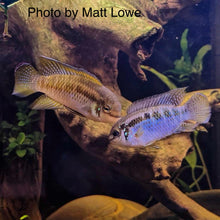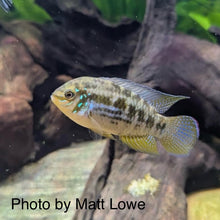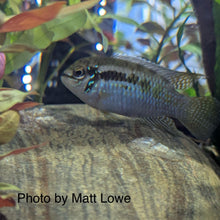Scientific name: Laetacara araguaiae
The genus Laetacara currently contains seven valid species and L. araguaiae can be distinguished from all congeners by possessing 7-8 dorsal-fin rays (vs. 9–10 in L. dorsigera, L. fulvipinnis and L. thayeri, 8–9 in L. curviceps and L. flamannellus, and 9–11 in L. flavilabris).
It further differs from L. dorsigera by possessing a narrow ectopterygoid (vs. wide), lesser head depth (80.0–88.7 % mm HL vs. 90.2–96.3 % mm HL), a shorter snout (snout length 26.7–32.2 % mm HL vs 33.0–37.9 % mm HL) and more scales in the longitudinal series (23–25 vs. 21–22).
It can be told apart from L. curviceps, L. dorsigera and L. flamannellus by lacking a dark spot on the dorsal-fin base (vs. possessing), from L. thayeri by possessing cycloid scales on the sides of the head (vs. ctenoid scales)and presence of a dark spot at the caudal-fin base (vs. absence), from L. flavilabris by having fewer total vertebrae (24 vs. 26) and fewer scales in the upper lateral line (12–14 vs. 15–18), and from L. fulvipinnis by possessing fewer scales in the upper lateral line (12–14 vs. 15–17), fewer scales in the lower lateral line (6–8 vs. 8–9) and lack of a dark dot at the edge of each scale on the midlateral portion of the flank (vs. presence).
Origin : araguaiae: named for the rio Araguaia, Brazil, to which this species is native.
Difficulty in keeping: Intermediate
Maximum size: 9-12cm Males 8-10 cm Females
Selling size: 3-4 cm and above (sizes are for males females might be smaller)
Temperature: 25 – 28 °C (26°C preferred)
pH: 6-7.8 Our fish are bred and grown at a ph between 4.5 and 7.5
Diet: Primarily carnivorous and apparently feeds mostly on benthic invertebrates in nature. In the aquarium live and frozen foods such as Brine shrimp, Daphnia and Blackworms should be offered regularly although most specimens will also learn to accept dried alternatives with pelleted products generally preferred to flake.
Disclaimer: Photos are taken of our own fish and usually the breeding parents, photos are for reference only and actual fish you will receive might slightly vary.






